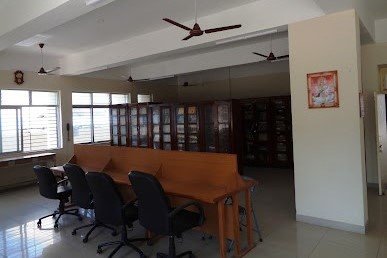
The Group of Parekh Colleges- Mahuva
(Affiliated To MKBU, GTU And Approved by AICTE)

The Group of Parekh College- Mahuva
(Affiliated To MKBU, GTU And Approved by AICTE) College Library

The Group Of Parekh College's
library is an invaluable resource hub and an intellectual haven for higher-education students. As a sanctuary of knowledge, it provides diverse books, journals, and digital resources catering to students’ academic needs and intellectual curiosities across various disciplines. Beyond its extensive collection, the college library offers a conducive environment for research, study, and collaboration, fostering a culture of academic excellence and intellectual exploration. With its welcoming ambiance, knowledgeable staff, and state-of-the-art facilities, the college library stands as a vibrant center of learning, supporting students in their quest for knowledge and fostering a deep appreciation for the power of information.
❀ Aims and Objectives of College Library:
The aims and objectives of a college library are vital in fulfilling its role as a valuable resource center within the institution. With a focus on supporting educational programs, fostering intellectual growth, and facilitating research, the library aims to provide a rich and diverse collection of materials beyond textbooks’ confines. By promoting deep and advanced studies, enhancing understanding across disciplines, and preparing students as responsible citizens, the library plays a crucial role in empowering individuals with knowledge and critical thinking skills. Furthermore, it serves as a hub of information, connecting faculty members with the latest updates in their fields and offering healthy entertainment options for its users. Some of the key aims and Objectives of a College Library are:
1) Support Educational and Instructional Programs:
The college library aims to actively support and enhance all educational and instructional programs offered by the institution. It provides resources, materials, and services that align with the curriculum, ensuring students access relevant information beyond their textbooks.
2) Foster Deep and Advanced Studies:
The library aims to cultivate a habit of deep and advanced studies among students. It offers resources encouraging students to delve deeper into subjects, explore diverse perspectives, and engage in independent research. The library facilitates intellectual growth and encourages lifelong learning by providing access to a wide range of materials.
3) Enhance Understanding of Subjects:
An objective of the college library is to enhance students' understanding of various subjects or disciplines. It offers resources that provide comprehensive and in-depth coverage of different fields, enabling students to gain a broader knowledge base and a deeper understanding of their chosen areas of study.
4) Prepare Responsible Citizens:
The library aims to prepare students to be intelligent, aware, informed, and enlightened individuals who can actively participate in society as responsible citizens. By providing access to diverse resources, the library fosters critical thinking, promotes civic engagement, and encourages a sense of social responsibility among students.
5) Assist in Research Work:
The library is vital in assisting research work. It offers resources, research support services, and guidance to students and faculty members engaged in research projects. The library provides access to scholarly journals, databases, and other resources necessary for conducting research, laying the foundation for academic inquiry and intellectual exploration.
6) Provide Latest Updates to Teachers:
The library aims to keep teachers informed about the latest developments in their respective subject areas. It acquires and disseminates new research findings, scholarly publications, and other relevant materials to ensure that faculty members stay updated and can incorporate the latest knowledge into their teaching.
7) Provide Healthy Entertainment Material:
Alongside its educational objectives, the library recognizes the importance of providing healthy entertainment material to its users. It offers a selection of recreational reading materials, including fiction, non-fiction, and popular magazines, to promote leisure reading and relaxation among students and faculty.
These aims and objectives reflect the role of a college library in supporting academic programs, fostering intellectual growth, facilitating research, promoting responsible citizenship, and offering a well-rounded educational experience to the college community.
Academic Librarian

Upadhyaya Hetal Gunvantrai
MLI.SC
❀ Purpose of a College Library
The college library is an intellectual hub within the academic landscape, serving as a multifaceted repository of knowledge, a haven for scholarly exploration, and a catalyst for academic achievement. Its primary purpose transcends the mere provision of books and resources; rather, it embodies the spirit of learning, inquiry, and research that defines higher education. At its core, the college library serves as a dynamic space where students and faculty converge to pursue knowledge, fostering an environment conducive to academic growth and intellectual inquiry. By curating an extensive collection of books, journals, and digital resources, the library becomes a reservoir of information that spans disciplines, supporting diverse academic pursuits. It is not merely a repository of texts but a gateway to a world of ideas, encouraging a spirit of curiosity and critical thinking among its patrons. Moreover, the library is a sanctuary for focused study and contemplation, providing a quiet refuge for individuals to delve into their academic endeavors. Beyond the physical collection, modern college libraries embrace technological advancements, offering digital databases, online journals, and collaborative spaces that reflect the evolving nature of scholarly communication in the digital age.
The purpose of a college library is multifaceted, encompassing a range of essential roles that contribute to the institution's academic mission and intellectual development. Here are several key purposes of a college library:
1) Gateway to Knowledge:
At its core, the college library is a gateway to knowledge, a treasure trove that houses a diverse collection of resources spanning various disciplines. Books, journals, periodicals, and digital databases collectively form a reservoir of information that supports the curriculum and research needs of the academic community. Through this curated collection, students embark on intellectual journeys, deepening their understanding of subjects and expanding their horizons.
2) Cultivating a Culture of Learning:
College libraries are not merely spaces filled with shelves but environments carefully crafted to foster a learning culture. Quiet study areas provide students with the solitude necessary for focused academic pursuits, while collaborative spaces encourage group discussions and interactive learning. In this nurturing atmosphere, individuals are inspired to explore new ideas, challenge assumptions, and engage in critical thinking that defines a robust education.
3) Supporting Research and Inquiry:
The library is a bastion for research and inquiry, offering rich resources that underpin academic investigations. Librarians, with their expertise in information retrieval, serve as invaluable guides, aiding students and faculty in navigating the vast sea of available knowledge. Whether embarking on a comprehensive research project or seeking answers to specific queries, the library is an indispensable partner in the scholarly journey.
4) Promoting Information Literacy:
College libraries play a crucial role in promoting information literacy in an era dominated by information overload. Librarians assist in navigating the wealth of resources and impart essential skills for critically evaluating information. Students emerge with a wealth of knowledge and the ability to discern reliable sources, an invaluable skill in an information-driven society.
5) Adapting to the Digital Age:
Embracing the digital age, college libraries seamlessly blend traditional and modern resources. Online databases, e-books, and multimedia materials augment the physical collection, ensuring information is accessible in diverse formats. Technology-enabled spaces within the library cater to the evolving needs of students, providing platforms for collaborative projects, multimedia creation, and interactive learning experiences.
❃ Total Books ❃
❀ Challenges of a College Library
Despite its importance and numerous benefits, the college library also faces certain challenges that can impact its effectiveness in serving the needs of students, faculty, and staff. These challenges include:
1) Budget Constraints:
College libraries often operate within limited budgets, which can restrict their ability to acquire new resources, update technology, and maintain the physical infrastructure. Budget constraints may reduce acquiring new books, journals, and databases, limiting the library’s ability to provide up-to-date and comprehensive materials.
2) Technological Advancements:
The rapid pace of technological advancements poses opportunities and challenges for college libraries. While technological advancements have revolutionized access to information, but they also require libraries to adapt and invest in new technologies constantly. Maintaining a robust digital infrastructure, providing access to electronic resources, and ensuring reliable internet connectivity can be challenging for some libraries.
3) Space Limitations:
College libraries often face challenges related to physical space. As the demand for study spaces, collaborative areas, and access to technology increases, libraries may find it difficult to accommodate the needs of a growing college community within the existing space. Limited space can impact the availability of study areas, the placement of collections, and the overall comfort of library users.
4) Changing User Needs and Expectations:
College libraries must continually adapt to their user's changing needs and expectations. Students and faculty now expect seamless access to resources, both physical and digital, from anywhere and at any time. Meeting these expectations while balancing the limitations of budgets and resources can be a challenge for libraries.
5) Copyright and Licensing Restrictions:
College libraries must navigate complex copyright laws and licensing agreements when providing access to digital resources. Compliance with copyright restrictions can be challenging, especially regarding electronic resources, interlibrary loan services, and document delivery.
6) Lack of Library-Centered Teaching:
College libraries often face challenges in integrating library resources and services into the curriculum. The lack of library-centered teaching means that students may not receive adequate instruction on effectively using the library or take full advantage of its resources for their academic pursuits.
7) Lack of Right Books:
Insufficient or outdated book collections can pose a significant problem for college libraries. The lack of appropriate books, particularly in specialized or emerging fields, can limit the resources available to students and faculty members.
8) Lack of Scientific Book Selection Policies:
College libraries may struggle with formulating and implementing effective book selection policies, especially in scientific disciplines. The absence of clear guidelines for acquiring scientific literature can result in an imbalanced collection and hinder access to up-to-date and relevant resources.
9) Escalating Cost of Books:
The rising cost of books can strain library budgets, particularly in academic and scientific fields. Limited funds may lead to difficulties in acquiring expensive books, which may impact the comprehensiveness of the collection and restrict access to essential resources.
10) Inadequacy of Books:
College libraries often face challenges related to physical space. As the demand for study spaces, collaborative areas, and access to technology increases, libraries may find it difficult to accommodate the needs of a growing college community within the existing space. Limited space can impact the availability of study areas, the placement of collections, and the overall comfort of library users.
 shreebalvantparekhedutrust@gmail.com |
shreebalvantparekhedutrust@gmail.com |  2844228332 |
2844228332 |  Login
Login